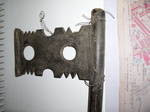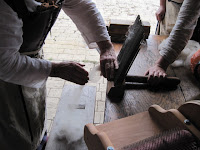wow! I think I have previously mentioned Valenki, traditional East European felt boots,
this web site has been passed on it shows the valenki production process and is well worth a look
www.muse.lt/keliones/kaip-gimsta-veltiniai-foto-reportaas
Thursday 1 July 2010
Friday 11 June 2010
Monday 7 June 2010
2010 in general and Wool Weekend 5/6th June
This summer I won't be feltmaking at the Kentwell Hall reenactment. I'll be working in the house making subtleties for "The Family". So I guess there won't be many, if any posts for this blog this year.
Last weekend I was, however at Wool Weekend with the Regional International Feltmakers Association group and the Lavenham Guild of Weavers, Spinners and Dyers. Alison, a Guild member, kindly brought along her wool combs, Widow Meg showed us how to use them and Alison donated them to Kentwell. When you see what they are like you will know why they are in safe keeping rather than lying around.
Last weekend I was, however at Wool Weekend with the Regional International Feltmakers Association group and the Lavenham Guild of Weavers, Spinners and Dyers. Alison, a Guild member, kindly brought along her wool combs, Widow Meg showed us how to use them and Alison donated them to Kentwell. When you see what they are like you will know why they are in safe keeping rather than lying around.
Sunday 25 April 2010
Carders
Further to my last posting "Lucy the Tudor" has kindly given me more information about the use if carders. Its a nuisance that I can't directly cut and paste directly into the blog so, if the following links don't work, its because I haven't typed them out correctly, let me know.
Here are some links which evidence the existance and use of hand carders. This is in addition to wool combs/ hackles and possibly other methods. I am keen to know what and how they are doing in the last painting!
Anyway here goes;
http://www.imagesonline.bl.uk/results.asp?image=071982
http://nuernberger-hausbuecher.de/75-Amb-2-279-16-v
http://museumoflondon.org.uk/English/EventsExhibitions/Permenent/med
http://www.themorgan.org/collections/collections.asp?id=108
In addition Lucy tell me that there are lots of images of long spikey wool combs and defends slow and careful carding rather than her own hasty and impatient (much less effective carding).
I've posted a link to your website as a thank you to Lucy - have a look - she makes and sells some lovely things for reenctors.
Here are some links which evidence the existance and use of hand carders. This is in addition to wool combs/ hackles and possibly other methods. I am keen to know what and how they are doing in the last painting!
Anyway here goes;
http://www.imagesonline.bl.uk/results.asp?image=071982
http://nuernberger-hausbuecher.de/75-Amb-2-279-16-v
http://museumoflondon.org.uk/English/EventsExhibitions/Permenent/med
http://www.themorgan.org/collections/collections.asp?id=108
In addition Lucy tell me that there are lots of images of long spikey wool combs and defends slow and careful carding rather than her own hasty and impatient (much less effective carding).
I've posted a link to your website as a thank you to Lucy - have a look - she makes and sells some lovely things for reenctors.
Thursday 22 April 2010
Hackles
Having been given a roasting by a lady whose "hackles" were up after visiting Kentwell to find a gaggle of girls half heartedy using modern carders to prepare wool. She was adament that these carders would not have been available (feel free to tell me differently) but that wool would have been prepared using "hackles". I followed her lead to find out more about hackles and how to use them. If you want to do the same, do a search on u-tube there are various videos of people using a variety of different hackles and wool combs (which look similar to hackles - just a bit smaller).
In the course of all this I came across a one video which I beleive may give an amazing insight into how wool might have been prepared and used in tudor times. Its called "what people do with wool in a rural part of Serbia" - do have a look, its amazing. They use their fingers and/ or hackles to prepare the wool; they spin in a variety of different ways; they appear to put a woollen garment into a fire; the immerse garments in water and beat them with a paddle. The paddle is just like those shown in a picture of washerwomen in tudor times (which I now cannot find). Do have a look at this video, once you get through the evocative music at the beginning it is absolutely fascinating.
OK not wool but wiki describes the use of hackles with flax; "in this process the fibre is pulled through various different sized hackles. A hackle is a bed on nails, sharp; long; polished steel pins drivne into wooden blocks at regular spacing. A good progression is from 12 pins per square inch; to 12; to 25; to 48; to 80. The first three will remove the straw and the last two will split and polish the fibres. Someof the finer stuff that comes off the last hackles can be carded like wool."
I'd love to find out more - can you contribute any information?
In the course of all this I came across a one video which I beleive may give an amazing insight into how wool might have been prepared and used in tudor times. Its called "what people do with wool in a rural part of Serbia" - do have a look, its amazing. They use their fingers and/ or hackles to prepare the wool; they spin in a variety of different ways; they appear to put a woollen garment into a fire; the immerse garments in water and beat them with a paddle. The paddle is just like those shown in a picture of washerwomen in tudor times (which I now cannot find). Do have a look at this video, once you get through the evocative music at the beginning it is absolutely fascinating.
OK not wool but wiki describes the use of hackles with flax; "in this process the fibre is pulled through various different sized hackles. A hackle is a bed on nails, sharp; long; polished steel pins drivne into wooden blocks at regular spacing. A good progression is from 12 pins per square inch; to 12; to 25; to 48; to 80. The first three will remove the straw and the last two will split and polish the fibres. Someof the finer stuff that comes off the last hackles can be carded like wool."
I'd love to find out more - can you contribute any information?
Friday 16 April 2010
Ryland Fleece - follow up
Well, I spent most of monday optimistically carding a whole ryland fleece. I tried to felt it today and was very fed up. Although lovely and soft I don't think Ryland is a wool for felting. It barely hung together. It is probably lovely to spin and knit which is, after all, what was said in the reference refered to beforehand.
Thursday 25 March 2010
Ancient China
This is incredible- delving back further into history there has been an amazing archeological find in China which indicates that there were caucasian peoples on their western boundaries around 3,000 years ago. Mummified bodies with wonderfully preserved textiles have been found. Some of the textiles have been made of felt.
If you would like to find out more about these finds have a look at these links
www.utube.com/watch?v=TkOcuzDCX-Uandfeature=related
www.utube.com/watch?v=pDMkWPAJ_YOandfeature=channel
If you would like to find out more about these finds have a look at these links
www.utube.com/watch?v=TkOcuzDCX-Uandfeature=related
www.utube.com/watch?v=pDMkWPAJ_YOandfeature=channel
Thursday 18 March 2010
Ryland Sheep
in "wooly wonderings" post published on 9th September 2008 I mentioned a reference to Ryland sheep wool in relation to Monmouth Caps. Since then I have periodically searched ebay to try and get hold of some of this fleece but to no avail. then guess what happened this evening? I was put in touch with a lady who offered me fleece from Shetland, North Ronaldsay and ... Ryland sheep.. how exciting - I can hardly wait!
to read more about Ryland Sheep have a look at www.freespace.virgin.net/a.wood/index2.html
to read more about Ryland Sheep have a look at www.freespace.virgin.net/a.wood/index2.html
heads and hats
found a new web site today www.thehatsite.com
it has all sorts of useful information - did you know for instance that
it has all sorts of useful information - did you know for instance that
- head shapes and sizes vary from country to country. In general the smallest, roundest heads are found in the far east. Western heads tend to be more oval in shape and the largest heads are, apparantly, found in Germany.
- hat sizes are measured by the circumference of the head just above the ears.
- You are not likely to find an adult head bigger that 64cm or smaller than 51cm circumference.
Monday 15 March 2010
communication
I came across the following web sites when searching for ways to enhance the way I speak to people when I am in the 16th Century
This site has an amzing list of proverbs - I couldn't believe how many are still in circulation
http://www.famous-proverbs.com/
A man called Ron Bailey has put the entire Tynedale Bible 1525 on line - what a labour of love that must have been. It gives a great insight into use of language at the time
www.wesley.nnu.edu/biblical_studies/tynedale
for ideas about day to day greetings and conversation
www.home.wwdb.org/atkinsonk/public_html/Basic_Faire_Speech.html
This site has an amzing list of proverbs - I couldn't believe how many are still in circulation
http://www.famous-proverbs.com/
A man called Ron Bailey has put the entire Tynedale Bible 1525 on line - what a labour of love that must have been. It gives a great insight into use of language at the time
www.wesley.nnu.edu/biblical_studies/tynedale
for ideas about day to day greetings and conversation
www.home.wwdb.org/atkinsonk/public_html/Basic_Faire_Speech.html
Subscribe to:
Posts (Atom)






